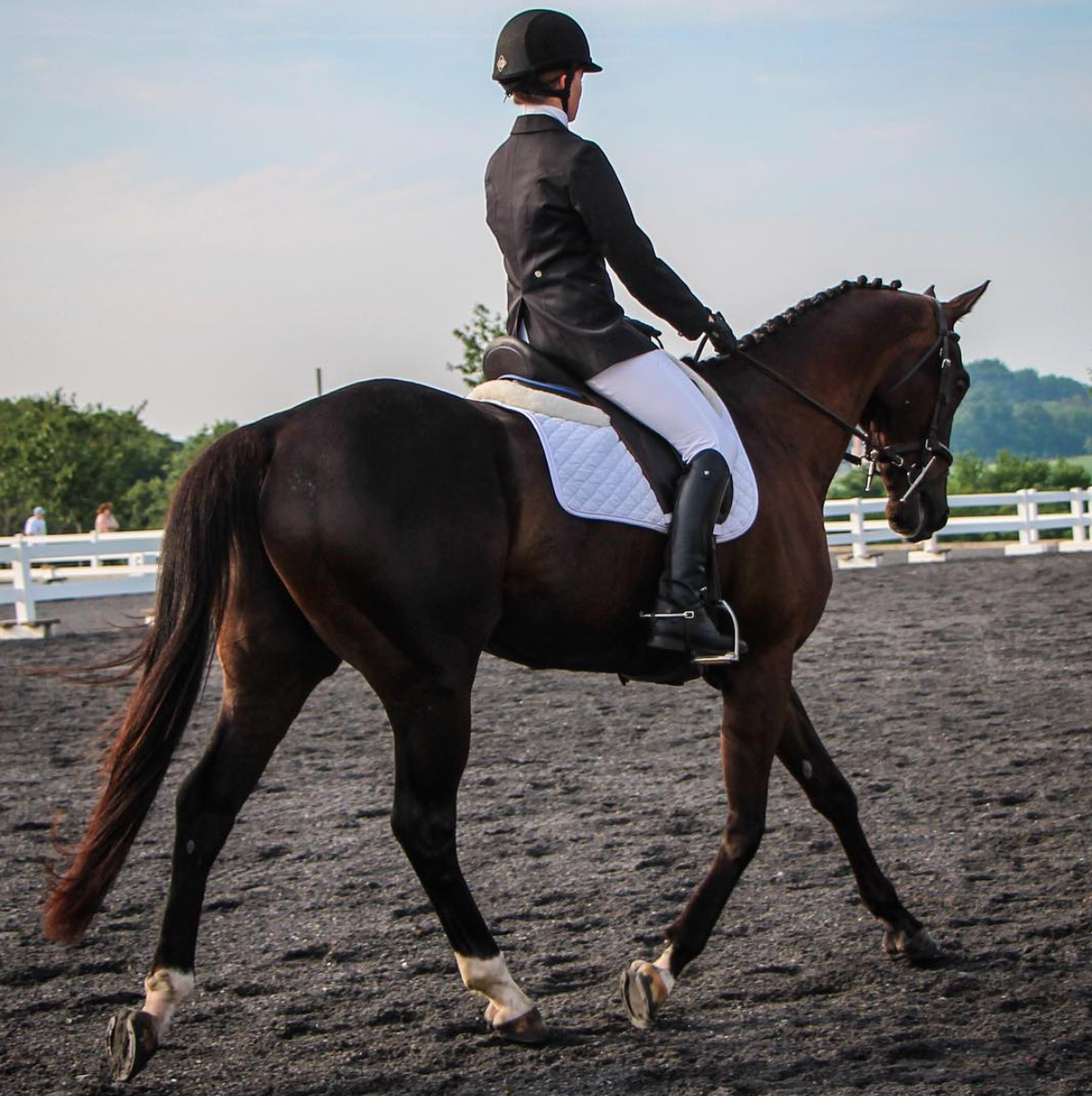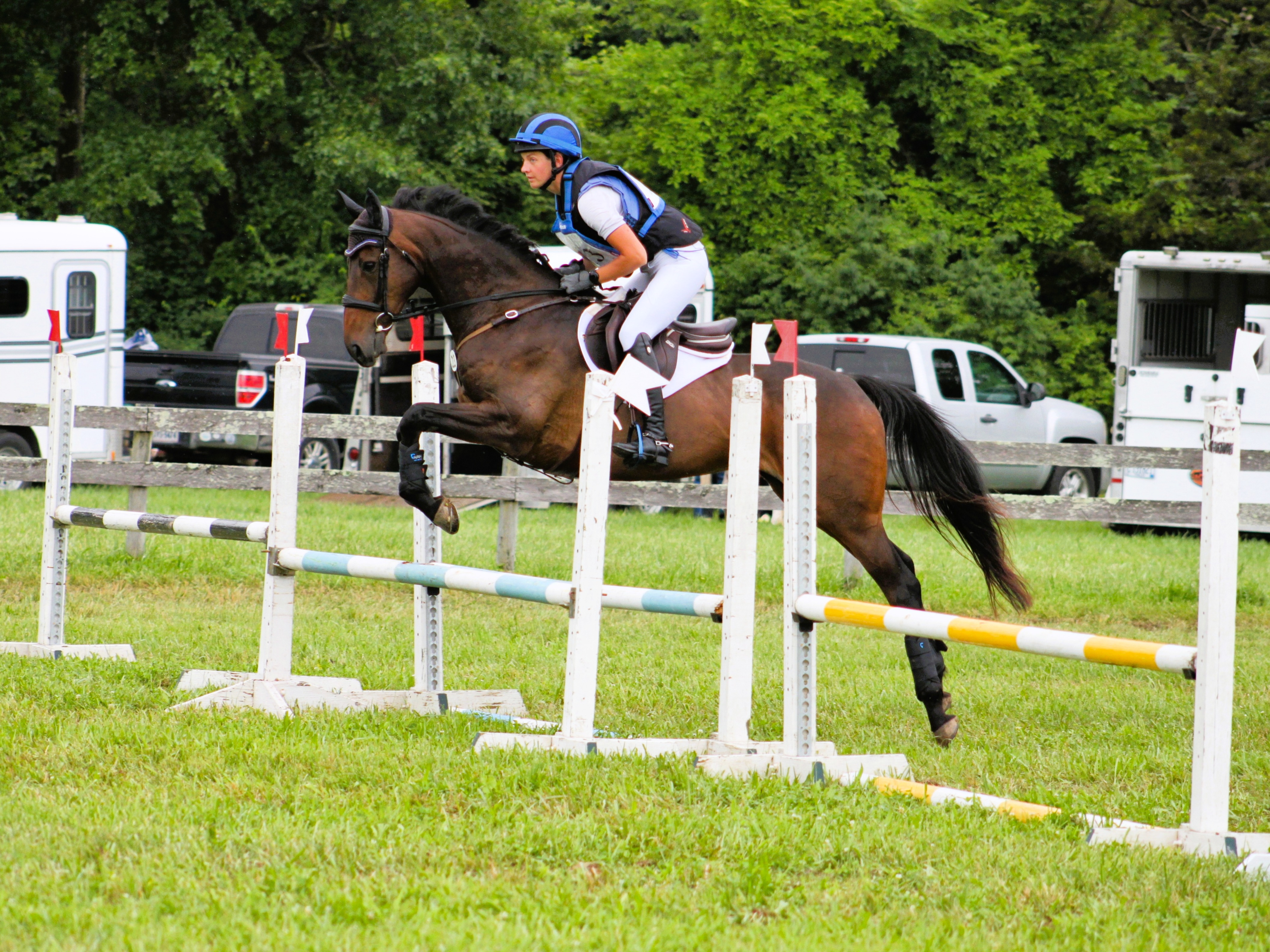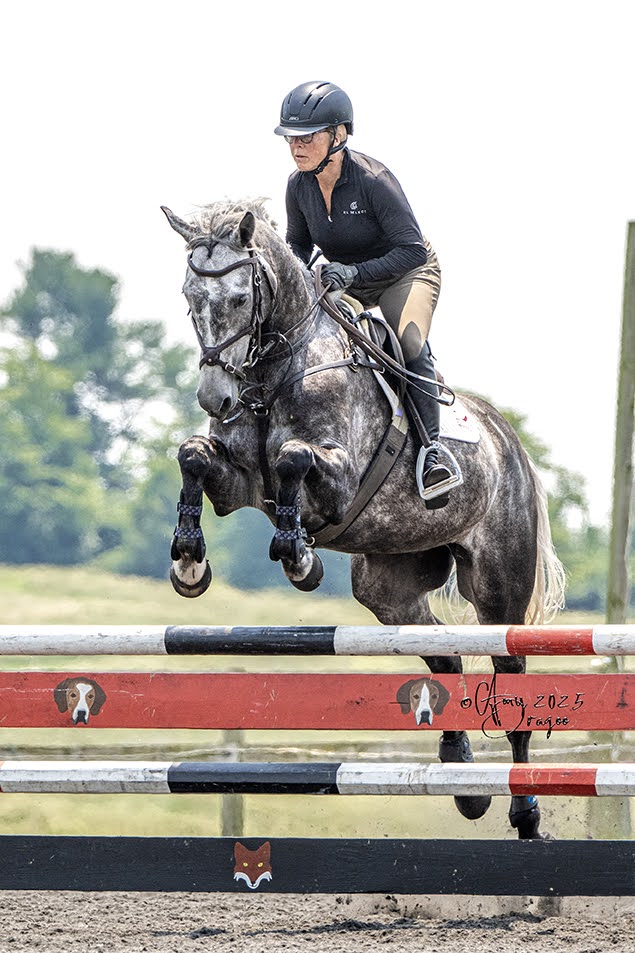“Our new Constitution is now established, everything seems to promise it will be durable; but, in this world, nothing is certain except death and taxes,” wrote Benjamin Franklin in 1789, before, we presume, scratching his chin with the feather-end of his quill and adding in a chicken-scratch scrawl, “oh, and that if London 52 is on the entry list, he’ll lead the dressage.”
In fact, we’d hasten to argue that, in a world where tax havens and Jeff Bezos exist, it’s actually probably more of an undeniable certainty that you’ll see Laura Collett and London 52 take the top spot on a first-phase leaderboard. So much so, in fact, that we’ve exhausted our normal line of questioning and are considering making a list of brand new and totally off-topic queries to ask the 2020 Pau winner after her performances: things like “what is London 52’s favourite colour?” “Do you think London 52 prefers N*SYNC or the Backstreet Boys?” “Who did London 52 support for the 2021 London mayoral election — and, indeed, who would have been his chosen candidate for the 1952 London mayoral election?” “If London 52 was a cheese, what kind would he be?” And, perhaps most importantly, “If Mr Bass is named for Chuck Bass from the seminal noughties CW drama Gossip Girl, which character is London 52?” (His stable name would suggest that he’s dishy Dan Humphrey, but his smokey eye leans more towards a latter-years Jenny, though considerably more tolerable.)

“Actually, I think of myself as more of a Dorota” — London 52, maybe. Photo by Tilly Berendt.
From an outside perspective, it can be all too easy to think of a partnership of this calibre as being utterly infallible on the flat, but London 52 is still a young and relatively inexperienced top-level horse at just twelve and as everyone who has ever trudged their way around a dressage arena knows, there’s always a marginal gain to be made somewhere. For Laura, the focus has been on ensuring that Dan’s confidence and rideability grows in tandem with his physical strength and maturity.
“The more rideable he is, the more I’m able to really ride those movements; he was always able to do them, but I sometimes felt like I was fudging it a bit and making sure they didn’t fall apart. Now, it feels like I can ride him into a shoulder-in or a half-pass and then say, ‘right, now show them what you’ve got.’ He likes this bit,” she laughs, but, she says, “he prefers to be on the surface and showing off.” That’s certainly what he was able to do today, and the difference felt marked for Laura, who we last saw campaign the gelding over the rather rolling terrain of Burnham Market’s dressage arena, in which he scored a 23.8.
“I felt at Burnham that he got a good mark, but he didn’t feel as good as he can,” she says. “Here, he felt like I could show him off — and he wanted to show off, which he didn’t want to do at Burnham. He was conservative there and didn’t want to do the biggest trot.”
Laura relishes the opportunity to let him bask in his own extravagance, partly because that tendency to perform isn’t necessarily something that came naturally to him: “he’s learnt to be a show-off; he was always a shy horse but now he believes in himself and everything that he’s doing. It shows, and it makes my job easy.”

Tom McEwen and Toledo de Kerser. Photo by Tilly Berendt.
Yesterday’s leaders Izzy Taylor and Monkeying Around slip down one spot to overnight second on 22.5, while Tom McEwen and his own Pau winner Toledo de Kerser slot neatly into provisional third place on a very respectable 23. This hardly an outlier score for the French-bred gelding, who regularly makes his presence known at the preferable end of the leaderboard, but for Tom, there were minor improvements to be found in his work — and those had come from a tactical bit of ringwork at home.
“We’ve been at home quite a lot and there hasn’t been much to do, so I’ve been riding through the Olympic test a bit,” he says. That test and this week’s, CCI4* test B, are remarkably similar: they utilise short, snappy transitions between lateral movements, they employ a mid-test halt and reinback and, crucially, they feature a much smaller walk section sans pirouettes, which means that riders have limited time and space to nail the transitions in, within, and out of the walk, and every step within the gait must be top quality.
“It very much suits him, with that little bit of walk, then the more complicated canter work and short, sharp trot work,” says Tom, who made a polished performance of the early segment of the test with its fiddly transitions from shoulder-in into a 10m demi-volte, from which the shift into trot half-pass can so easily get sloppy or disjointed.
Though Aston — which is regularly used for Team GB’s training sessions — could offer some advantage to horses who are familiar and comfortable with it as a venue, Tom admits he never usually has much luck in this phase here: “We’re very lucky to be back at Aston,” he laughs, “but at the same time, I usually do my worst tests here!”

Tina Cook’s Billy the Red skips through his changes. Photo by Tilly Berendt.
In fact, today’s leaderboard in this phase has become something of a showcase of Britain’s top talent – and certainly, they continue to make the British selectors’ jobs that much harder with their impressive performances. Pippa Funnell and her reigning Burghley champion MGH Grafton Street sit fourth on 24.5, while Nicola Wilson and Bulana, Sarah Bullimore and Reve du Rouet and Tina Cook and Billy the Red all slot in a penalty behind them on 25.5 for a three-way tie for fifth place overnight. Though we’re used to seeing excellent marks from each of these partnerships, it was Tina who was most delighted by the feeling she got in the ring — and the enthusiastic praise bestowed upon her outside of it by British team coach Dickie Waygood.
“I don’t often get praise like that,” she laughs. “All my life I’ve found the dressage frustrating; I always seem to have had sharp horses who are brilliant in the jumping phases, but then do slightly struggle. I’m a tall girl and I find it hard to look elegant! But both horses [Billy the Red and Calvino II, 19th on 27.4] went well today.”
Team stalwart Billy has been a particularly fond frustration for the rider, who has had to work hard to manage his innate sharpness — a problem that has occasionally cropped up in the dressage ring.
“[Billy] has just got a bright brain; he’s not malicious, and he’s not nasty — he was just born bright and it’s just about finding the key. He isn’t one you’d want to overwork, as he’d probably get worse, so it’s just that fine line of doing twenty minutes and then hoping,” she explains. “He’s desperately spooky — oh my god — on hacks and stuff like that. When I rode him this morning he spooked at a pile of stinging nettles, slipped, and whipped ’round. He’s always the same, but that’ll be him all his life; sometimes he spooks at flowers, sometimes he doesn’t, and so I always have to prepared for the unexpected. You just have to smile your legs around him, smile, and get on with it! I ride him at home myself — I don’t think it’s fair on anyone else to have to ride him just in case anything happens, so it’s me and him all the time.”

William Fox-Pitt and Little Fire. Photo by Tilly Berendt.
William Fox-Pitt fell just short of joining the tie when he scored a 25.7 with Little Fire, who had originally been tentatively aimed at Kentucky before swapping places with Oratorio for the big trip overseas. Unlike the trio of women just ahead of him, though, William doesn’t see this week’s competition as part of a longer road to Tokyo this summer.
“He’s missed his Olympic slot, and there’s nowhere to really get selected from, so that’s fine,” he says, musing that “if enough horses go lame, perhaps we’ll get picked for the Europeans. It would be fun to go to Switzerland.”
As an onlooker, one can’t help but feel that William is rather underselling himself and the horse as a combination — always a flashy sort, ‘Aidan’ looked every inch the performer in the arena.
“He always feels pleased with himself — he’s never lacked in that self-confidence,” says William wryly. “It was good for him to do a grown-up test, as we’ve not done one this year. The last one he did would have been Burgham [in August of 2020] — that’s quite a long time in a horse’s life!”
Most notable, perhaps, was the work just prior to entering at A — as William and Aidan trotted around the perimeter of the arena, a sudden burst of elevation saw them working in a pace more akin to a passage.
“He has got a good trot in there that I’ve been working on, though it doesn’t always come out. If one of the girls — Pippa or Piggy — was on him, he’d do it all the time, but they’re not, so I’m working on getting there,” says William. “Overall, I was very pleased with what was a mistake-free ride — other than one little twitch of his nose — and that’s what I wanted.”

Ros Canter and the ultra-consistent Zenshera. Photo by Tilly Berendt.
Piggy March and Brookfield Inocent drop from their overnight second-placed position to ninth going into the jumping phases, while the top ten is rounded out by Ros Canter and ‘family pet’ Zenshera, who scored a 26.1 after delivering what a delighted Ros dubbed his best-ever test.
“I think he probably did the best test he’s ever done in his life; I was just so chuffed with him today,” she beams. “Little Zenshera just stayed with me so well; I don’t think I could have ridden any movement for him to have gone any better. Every one, he did to the best of his ability — previously, he’s made the odd mistake and he can get a bit ahead of himself, and enjoys himself a bit too much, but today was a real clear round. Obviously showjumping is our weak link, so we’ll enjoy what he did today, give him lots of pats, and hope it inspires him to pick up his toes tomorrow!”

The top ten at the culmination of dressage in CCI4*-S Section A.
Yesterday’s Section B leaders Piggy March and Brookfield Quality remain unusurped atop the leaderboard today on their score of 21.7, but behind them, there were a plethora of new additions to the top ten.
It was a good day in the office for Ros Canter, who put a 21.8 on the board with the relatively inexperienced Lordships Graffalo to tie for second place with Tom McEwen and Dreamaway II.
“He’s a really exciting young horse – he’s just lovely and rideable in the arena and as a big horse, he gets stronger every year,” she says of the nine-year-old British-bred Sport Horse, who tackles his third — and what will arguably be his most challenging — CCI4*-S this week. It feels like kismet, a bit, that he should be tied with Tom – after all, it was he who deputised for Ros in 2019, competing Lordships Graffalo at two- and three-star while his usual pilot was pregnant.

Tom McEwen and Dreamaway. Photo by Tilly Berendt.
For Tom’s part, his own 21.8 represents his career-best international score – a fact that might seem almost unbelievable considering the prowess of his five-star winner Toledo de Kerser in this phase. Although Dreamaway has been a consistent performer between the boards across his twelve international starts, we tend to expect a score around the 28.5 mark for the gelding, and his own previous best score was a 25.3 at the CCI2*-L level.
Alex Hua Tian and his Olympic partner Don Geniro produced a characteristically extravagant, correct test to put a 22.5 on the board next to the Chinese flag – the only instance of another nationality making it into either section’s top ten. They sit in overnight fourth place, followed by an on-form Harry Meade, still riding high after his fifth place finish at Kentucky last month.

Harry Meade and Red Kite. Photo by Tilly Berendt.
Here, all eyes were on the under-the-radar Red Kite, who comes forward for his sophomore CCI4*-S and who scored a wholly unexpected 22.7 to move up into fifth. Well, unexpected for everyone, that is, except Harry himself: “He’s got loads of ability, but he’s quite spunky – if he was a pupil in a class, you’d say that if he stopped mucking about, he could be a scholar! He’s got lots of capability.”

William Fox-Pitt and Georgisaurous. Photo by Tilly Berendt.
William Fox-Pitt makes a double appearance in the Section B top ten with the relatively inexperienced Georgisaurus, who returns to international competition for the first time since 2019. Then, we saw him start — though not complete — his CCI4*-S debut at Blenheim, and the now-ten year old has obviously used his time at home well. He scored a 23.6 today, considerably lower than his usual mid-to-high 20s marks, but a stroke of brilliance that was hinted at when we saw him put a 20.5 on the board in the CCI3*-L at Tattersalls two years ago. He sits sixth overnight, while stablemate Grafennacht — slightly more experienced, with a CCI4*-S and CCI4*-L completion under her belt already — lies ninth on 24.5.
“I’ve never pretended to be a dressage queen but I’m trying, still — and still enjoying it,” says William.”They both had little mistakes but were very pleasing — they’re lovely horses on the flat. We’ve got some work to do but I was so pleased with their brains, particularly as they’re inexperienced and neither has done an Advanced test in eight months.”
Between the two sit Kitty King‘s Cristal Fontaine — who we saw take the win at Burnham Market last month — in eighth on 23.7, and Gemma Tattersall and Jalapeno III, who posted a 23.6 yesterday. The top ten is rounded out by Yasmin Ingham and Sandman 7, who we saw put a 25.4 up in yesterday’s session.
Tomorrow sees the showjumping and cross-country phases play out in tandem, with over seven hours of action over the course of the day. And although the quality of the dressage scores across the two sections might make your eyes water a little bit (or it should, at least — you have to look as far as 34th place to find someone whose score begins with a ‘3’), there’s plenty left to do, including a big, technical showjumping track on grass and, of course, a brand new four-star cross-country course that has been designed to give these horses and riders a true test for the level. With scores this tightly bunched, we’ll be expecting the leaderboard to look very different by tomorrow night.
We’ll take a closer look at Captain Mark Phillips’ challenging track this evening — so keep it locked onto EN for all you need to know, and as always, Go Eventing!

The top ten after dressage in CCI4*-S Section B.
Aston-le-Walls International: Website | Ride Times and Live Scores | EN’s Coverage | EN’s Twitter | EN’s Instagram

























































